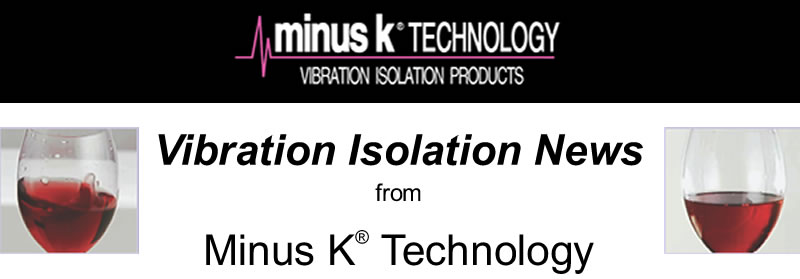
Number 4, October
2009

What's Here for You:
Vibration Isolation News is designed to keep our customers and friends up to date on the latest products and applications designed to facilitate better measurements and improved nanomanufacturing. We are an OEM supplier to leading manufacturers of scanning probe microscopes, micro-hardness testers and other sensitive instruments, and we have users at more than 200 leading universities and private and government laboratories in 35 countries.

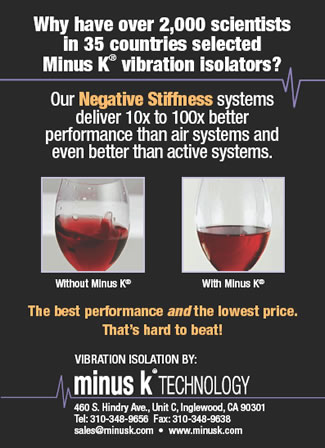 INDEX
INDEX
1. Minus K's Technology Selected for
James Webb Space Telescope Ground Testing
2. New Features on our Website
3. New WS-4 Compact Vibration
Isolation Table Conserves Valuable Lab Space!
4. Featured
Application: The Brain Game at Yale University - How Negative
Stiffness Technology Enabled the Laboratory to Achieve
More Accurate Results while Helping the Experimenter to
Save Time
5. Upcoming Nanotechnology
Meetings and Webinars
6. Your comments and suggestions

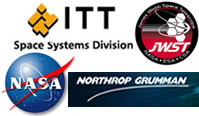
Minus
K Technology's Negative-Stiffness Vibration Isolators
Selected
for James Webb Space Telescope Ground
Testing
T(Inglewood, California, June 16, 2009) - Inglewood, California, April 20, 2009, Minus K Technology, Inc. has been selected by ITT Space Systems, LLC, subcontractor to Northrop Grumman Corporation (NYSE:NOC), to provide vibration isolators for the ground testing of the new James Webb Space Telescope (JWST) at the Johnson Space Center (JSC). The JWST will be placed in a vacuum chamber at the Johnson Space Center and supported by a set of custom Minus K vibration isolators.
The James Webb Space Telescope is a large-aperture infrared space telescope currently planned to be launched in 2014 from Kourou, French Guiana aboard an Ariane 5 launch vehicle. JWST is designated to succeed the Hubble Space Telescope.
"A major factor in selecting Minus K is its ability to not only isolate vibrations vertically, but also horizontally at less than 1 Hz," says Dr. David Platus, president of Minus K and principal inventor of the patented Negative-Stiffness Mechanism technology that is the key to the passive vibration isolators. "Minus K's isolators offer better isolation performance than air and active isolation systems.
Minus K Technology, Inc. works with many aerospace and education laboratories for custom vibration isolation systems. It also has a line of standard bench-top and table vibration isolation products.
(Below is a drawing of how the Minus K isolators will be used for Ground Testing)

For
additional information about Minus K's capabilities, contact:
Steve Varma, Operations Manager
Minus K Technology, Inc.; 460 South Hindry Ave., Unit
C, Inglewood, CA 90301; Phone 310-348-9656
email: stevev@minusk.com; www.minusk.com

New features on Minus K Technology's Website:
We have added
many new features to our website, including a selection
guide, product manuals, descriptions of some of our customers'
experiences using our products and articles describing unique
applications of Minus K products solving vibration isolation
problems.
Check
it out at www.minusk.com

Featured Product: NEW WS-4 Compact Vibration Isolation Table
Conserves valuable lab space!
The WS-4 is a cost effective vibration isolation table for weight loads up to 700 lb. It's a completely passive 6 degree of freedom system requiring NO Air and NO Electricity with our signature 1/2 Hz performance for both vertical and horizontal axis's.
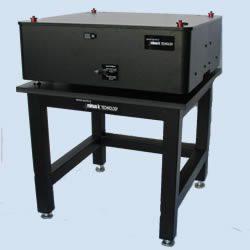
Features/Benefits:
- Vertical
natural frequency of 1/2 Hz or less can be
achieved over the entire load range.
- Horizontal
natural frequency is load dependent.
- 1/2 Hz or less can be achieved at or near the normal load
Typical
Vibration Control Applications for the WS-4 Compact Vibration
Isolation Table
The WS-4 Series offers the ultimate performance for
a wide range of instruments, such as analytical balances,
cell injection, confocal microscopes, patch clamping, optical
microscopes, wafer probing, sensor calibration, atomic force
microscopes and other sensitive equipment in fields such
as semiconductor processing, telecommunications, aerospace
engineering, and medical research.
https://minusk.com/content/products/standard/vibration_isolation_tables_anti_vibration_table_WS-4.html

New features on Minus K Technology's Website:
We have added
many new features to our website, including a selection
guide, product manuals, descriptions of some of our customers'
experiences using our products and articles describing unique
applications of Minus K products solving vibration isolation
problems.
Check
it out at www.minusk.com

The
Brain Game
Yale
University uses negative-stiffness vibration isolation to
stabilize microscopy in sensitive micron-level brain-imaging
research.
Excerpted From Laboratory Equipment -
October 2008
By
Jim McMahon
For 42 years, the Yale School of Medicine has been conducting
research on neuronal activity in brain cells to develop
methods for imaging brain activity. Yet it was not until
several years ago that the university opted to move to a
higher level of vibration isolation technology to support
its microscopy imaging, which is conducted at the micron
level.
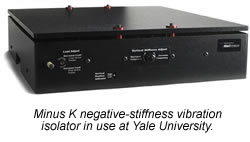 It
is not unusual for universities, and industry for that
matter, to have problems with site vibration, which
compromise to a greater or lesser degree the imaging
quality and data sets they acquire through microscopy.
Although every lab wants to eliminate unwanted vibration,
conventional systems such as air tables have not been
successful in providing an adequate level of vibration
isolation for ultra-sensitive equipment measuring at
the Angstrom and micron levels.
It
is not unusual for universities, and industry for that
matter, to have problems with site vibration, which
compromise to a greater or lesser degree the imaging
quality and data sets they acquire through microscopy.
Although every lab wants to eliminate unwanted vibration,
conventional systems such as air tables have not been
successful in providing an adequate level of vibration
isolation for ultra-sensitive equipment measuring at
the Angstrom and micron levels.
It is
not unusual for universities, and industry for that matter,
to have problems with site vibration, which compromise to
a greater or lesser degree the imaging quality and data
sets they acquire through microscopy. Although every lab
wants to eliminate unwanted vibration, conventional systems
such as air tables have not been successful in providing
an adequate level of vibration isolation for ultra-sensitive
equipment measuring at the Angstrom and micron levels.
Such was the case with the Department of Cellular and Molecular Physiology Lab, where air tables had been the mainstay for the lab's vibration isolation. The tables, however, were not able to provide adequate isolation to conduct neuronal research at the micron level.
Measuring
brain activity
Many
individual neurons or brain areas are active at once, explains
Professor Lawrence E. Cohen, head of the department's lab.
Yet conventional electrode techniques allow only one or
a few neurons or locations to be monitored at once. This
is only one example of why studying the brain is difficult.
"We have worked on several variations of an optical
method for measuring brain activity, utilizing both voltage-
and calcium-sensitive dye methods to study neuron activity,"
says Cohen. "In favorable preparations, the spike activity
of about 500 individual neurons or thousands of brain regions
can be monitored simultaneously. These methods have good
temporal (msec) and spatial (tens of microns) resolution."
Monitoring
multiple neurons or regions simultaneously can improve researchers'
understanding of how nervous systems are organized. Dr.
Cohen's lab recently used these methods to study the processing
of olfactory information in a turtle and mouse.
"We have obtained maps of the input to the olfactory
bulb that define the responsiveness of individual olfactory
receptor proteins. In the future, we hope to obtain maps
of the output of the bulb. A comparison of the two maps
can provide a powerful description of the role of the olfactory
bulb in processing olfactory signals," states Cohen.
"Depending on the dye, we can view the voltage across
the neuron membrane or the calcium concentration inside
the neuron," Cohen explains. The voltage is the signal
the cell uses to carry information from one end to the next,
much like how cells in the human spinal cord receive information
from and send information to the toes.
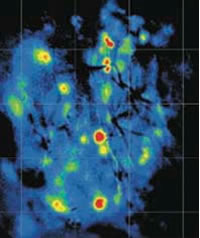 When
the lab uses a low magnification objective to form an
image of a vertebrate brain on the high-speed NeuroCCD-SMQ
camera or the NeuroCCD-SM256 featuring 256x256 pixels,
each pixel receives light from hundreds or thousands
of neurons. These population signals monitor coherent
activity-those events that involve simultaneous changes
in activity of a substantial fraction of the neurons
in the imaged region.
When
the lab uses a low magnification objective to form an
image of a vertebrate brain on the high-speed NeuroCCD-SMQ
camera or the NeuroCCD-SM256 featuring 256x256 pixels,
each pixel receives light from hundreds or thousands
of neurons. These population signals monitor coherent
activity-those events that involve simultaneous changes
in activity of a substantial fraction of the neurons
in the imaged region.
Response
to odor in olfactory receptor neuron nerve terminals
in the mouse olfactory bulb. (pictured on right)
Vibration noise
"Measuring
in the dimension of microns still requires vibration isolation
because it is so small," says Cohen, as the slightest
movement has a huge effect. "If you are viewing at
ten microns and the lab vibrates by ten microns, then you
are in big trouble."
When the Yale decided to employ a higher level of vibration
isolation, they invested in Minus K Technology, Inc., which
Dr. David L. Platus founded in 1993. Platus is not only
the company's president but also the inventor of the negative-stiffness
mechanism technology.
According to Cohen, the Minus K BM-10 benchtop vibration
isolation platform offers better results than the air tables
previously used the lab. The (air) table performed poorly
in the X/Y plane, yet the isolator reduces vibration in
the X/Y plane just as well as in the Z plane. Measuring
only 4.6" X 12.2" X 12.2", the platform offers
a 1.5-Hz horizontal and 0.5-Hz vertical natural frequency.
Plus, there are only two adjustments.
"For years, we have worked hard to get rid of vibration
noise, with only partial success," explains Cohen.
The lab is located on the first floor, but Cohen knew from
experience that they would have been better off in the basement.
"I would spend five to 10 percent of my time worrying
about vibrations," he says. However, after the lab
employed the use of the negative-stiffness system, his team
has not had to worry about vibration noise ever since."
The full article can be found at:
https://minusk.com/content/in-the-news/laboratory_equipment_october_2008.html

Upcoming Meetings and Webinars:
| Meeting: | Sponsor: | Dates: | Location: |
| ASPE 2009 Annual Meeting | American Society for Precision Engineering | Oct.
4, 2009 - Oct. 9, 2009 |
Monterrey, California |
| 4th International Conference on surface coatings and Nanostructured Materials | Multiple Sponsors | Oct.
19, 2009 - Oct. 22, 2009 |
Rome, Italy |
| 10th Inter-American Congress of Electron Microscopy | CIASEM: The Inter-American Committee of Societies for Microscopy | Oct.
25, 2009 - Oct. 27, 2009 |
Rosario City, Argentina |
| ICANN 2009 International Conference on Advanced Nanomaterials and Nanotechnology | Indian Institute of Technology | Dec.
9, 2009 - Dec. 11, 2009 |
Guwahati, Assam, India |
| SPIE Photonics West | CIASEM:
The Inter-American Committee of Societies for Microscopy Visit the Minus K Booth at this exhibit |
Jan.
26, 2010 - Jan. 28, 2010 |
San Francisco, CA |
| NSTI Nanotech 2010 | Nano
Science and Technology Institute Visit the Minus K Booth at this exhibit |
Jun.
20, 2010 - Jun. 24, 2010 |
Anaheim, CA |
Tell a colleague: A condensed description of our products is now available in ten languages in addition to English in order to make it easier for people to find them and to get started:
![]()
Check it
out at www.minusk.com

Comments/Suggestions: Applications in New Fields or Features of Interest to You in Our Next Newsletter:
If you want
to share your application with our readers, please send us a description
so that we can publish it in an upcoming newsletter. If you have
comments or suggestions we would be very interested to read them.
Please send any materials to: david.resnik@minusk.com

Tel: 310-348-9656 Fax: 310-348-9638
Contact Us www.MinusK.com
© Minus K Technology Inc., Vibration Isolation Systems. All rights reserved.